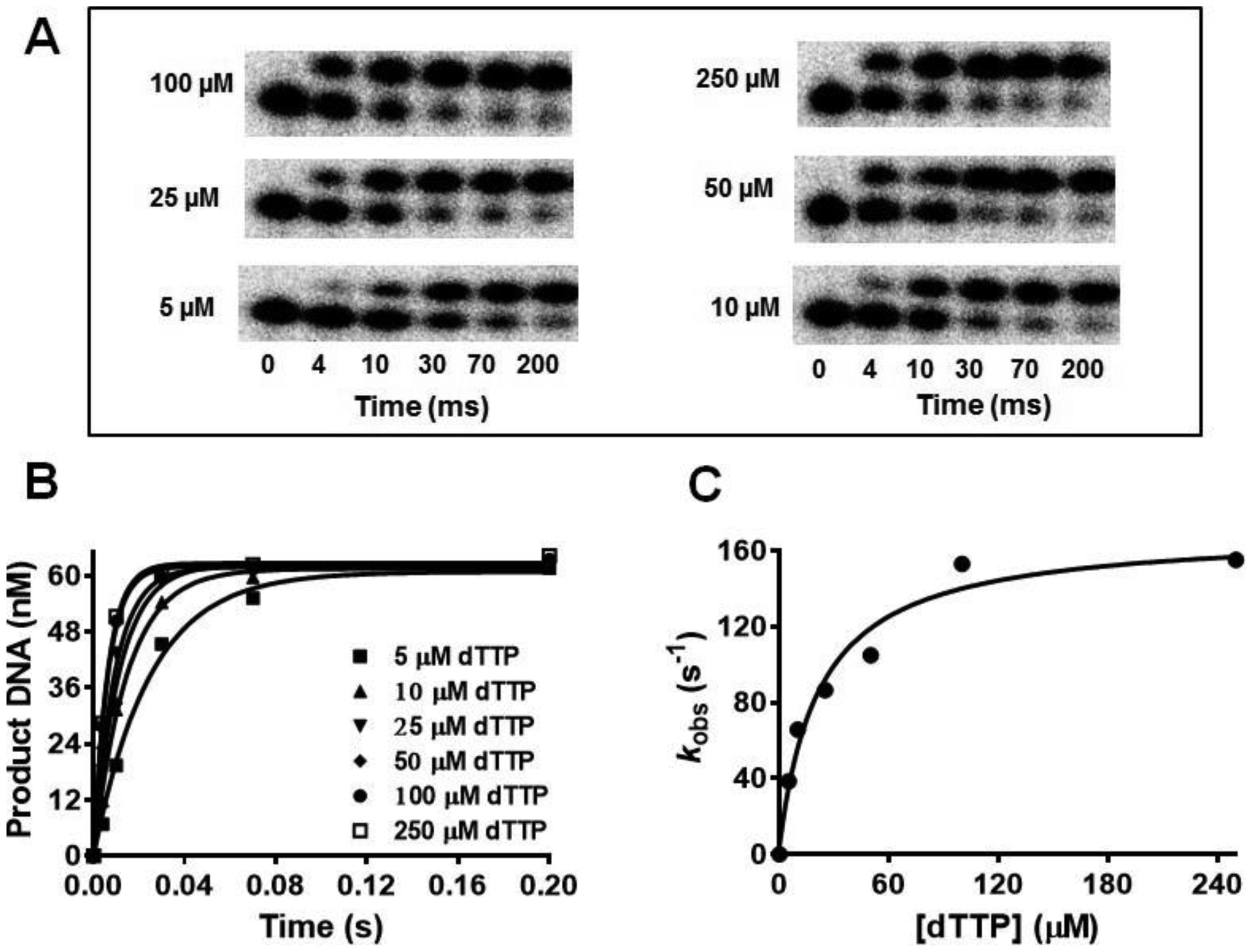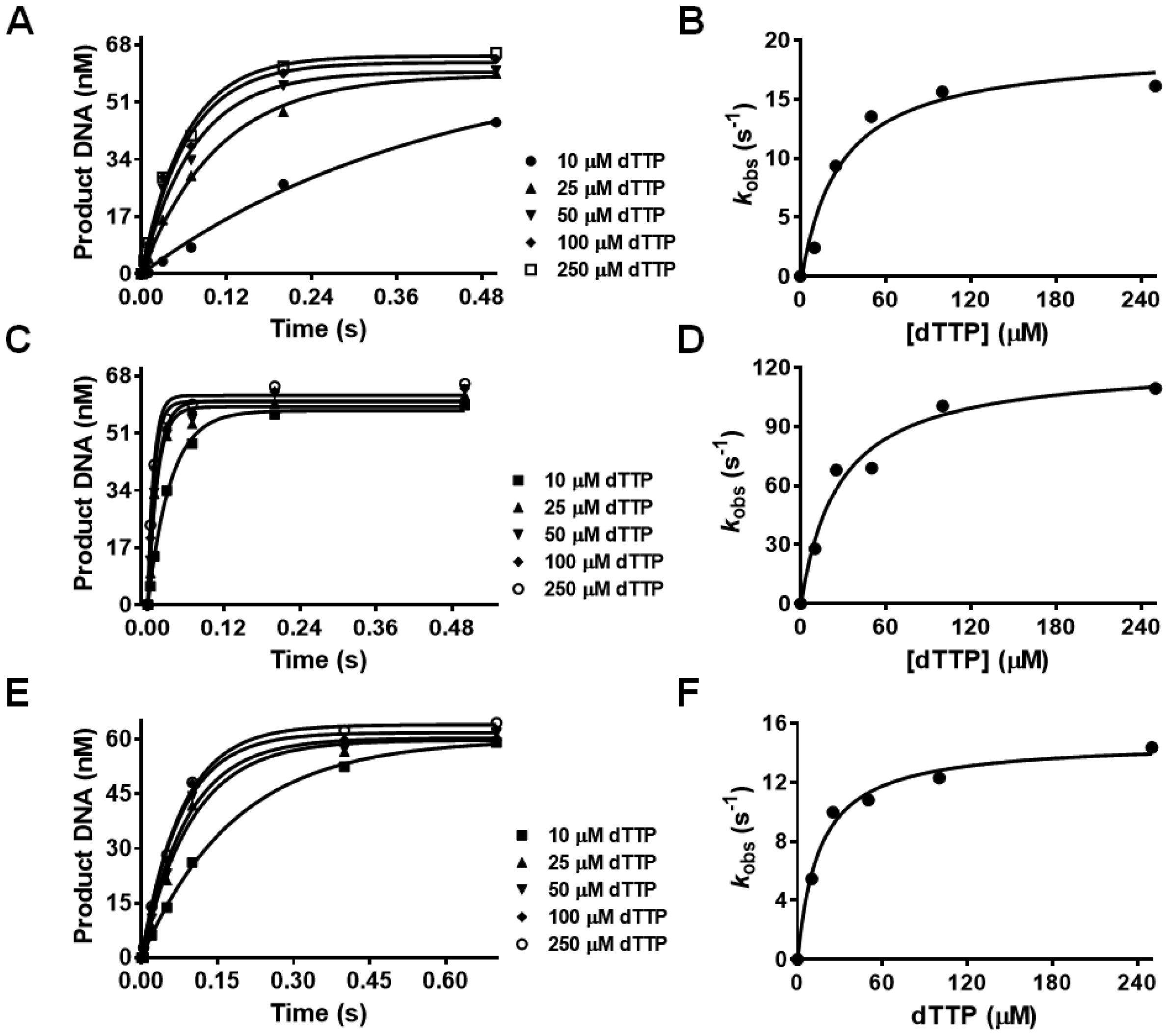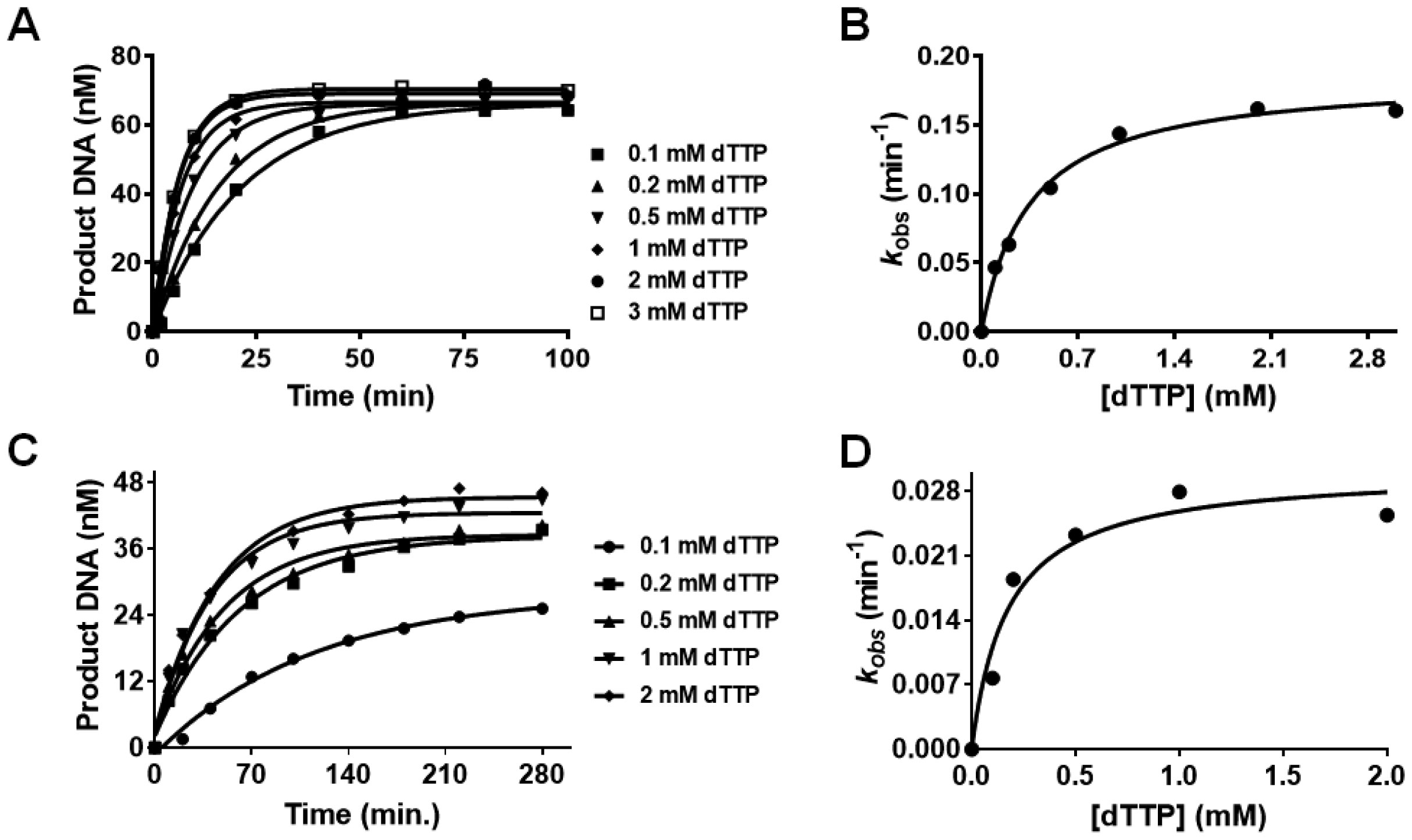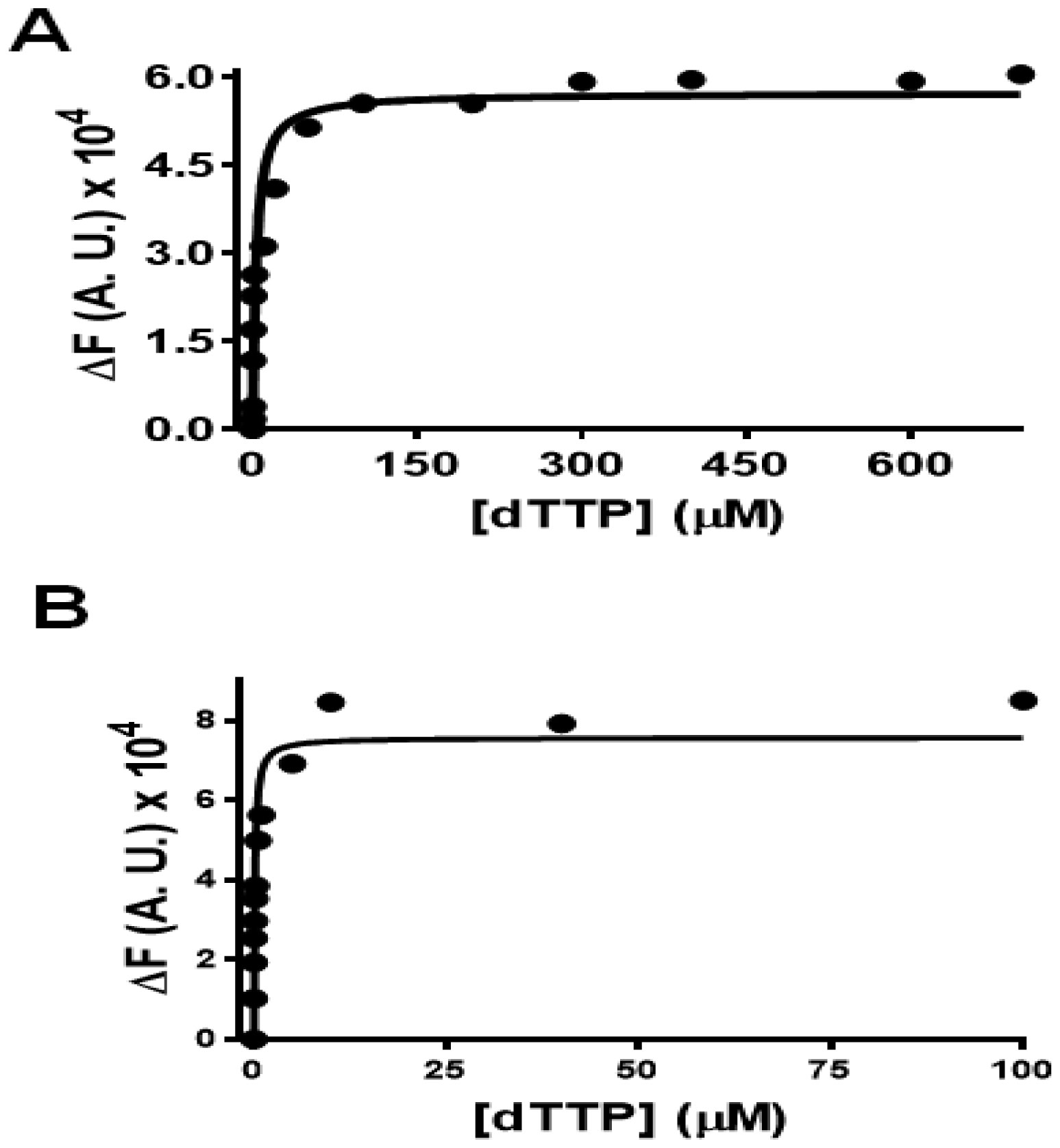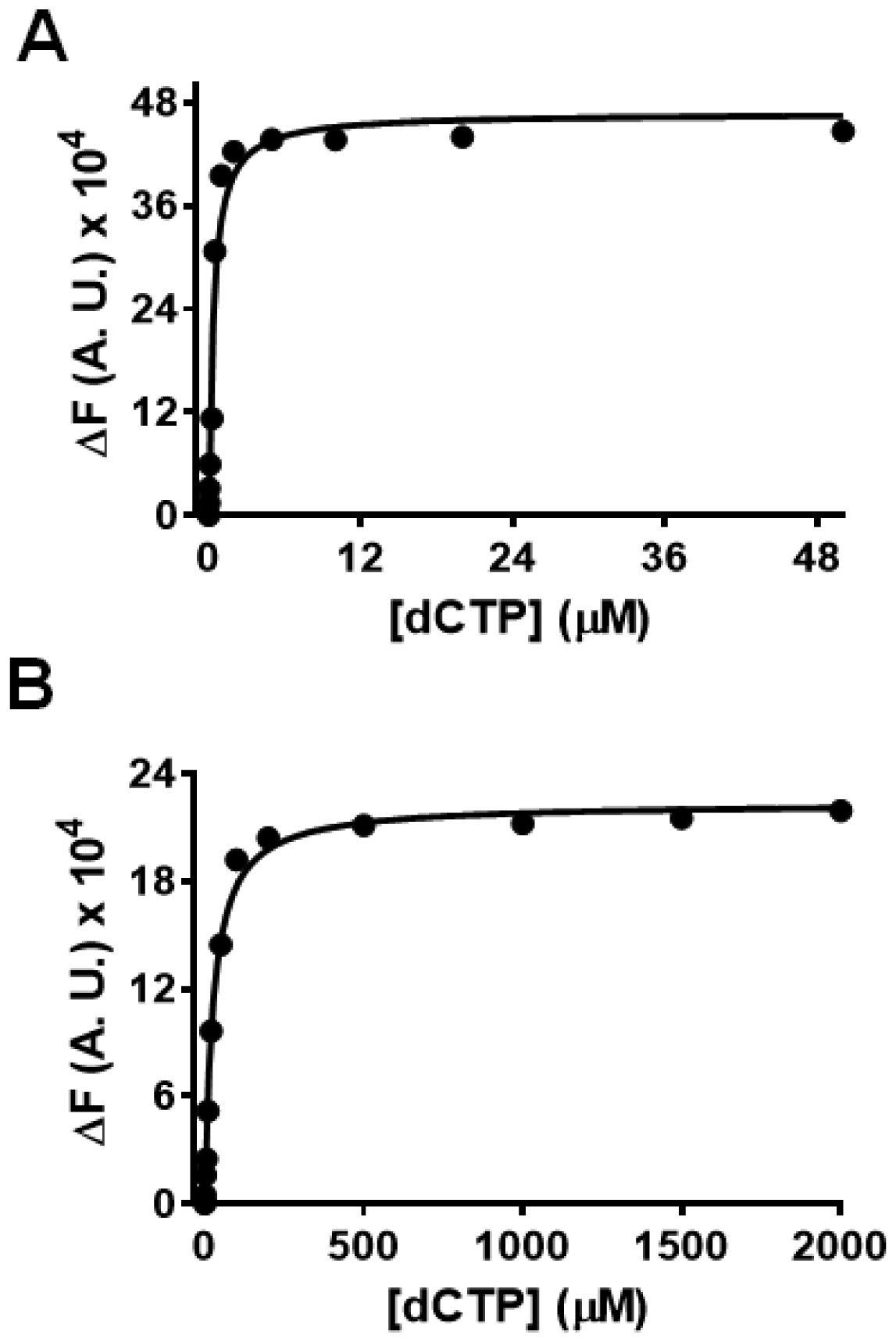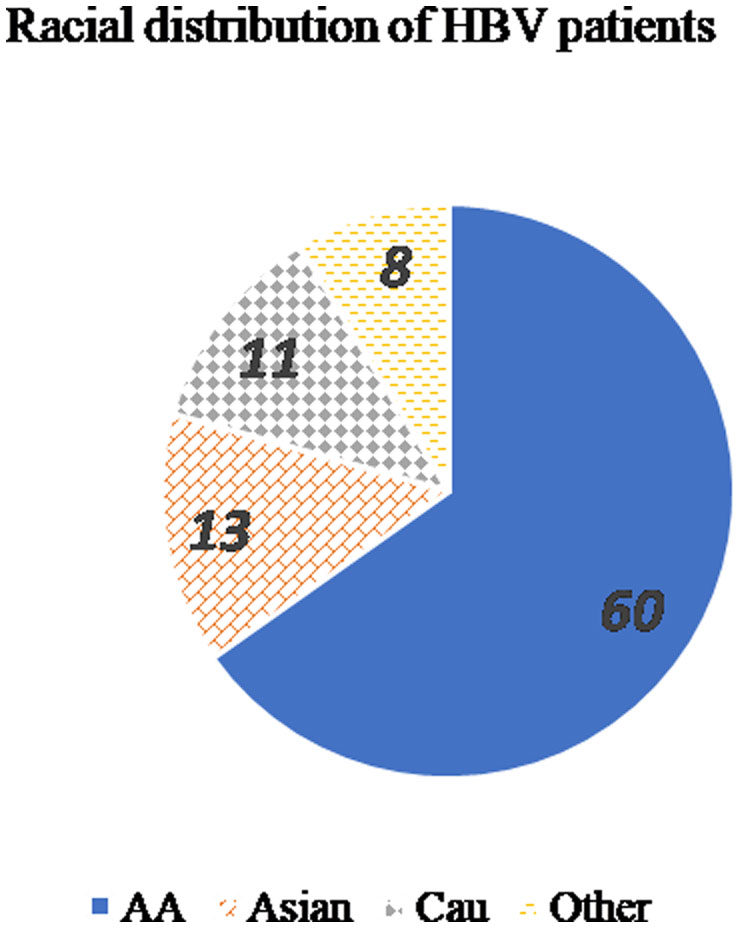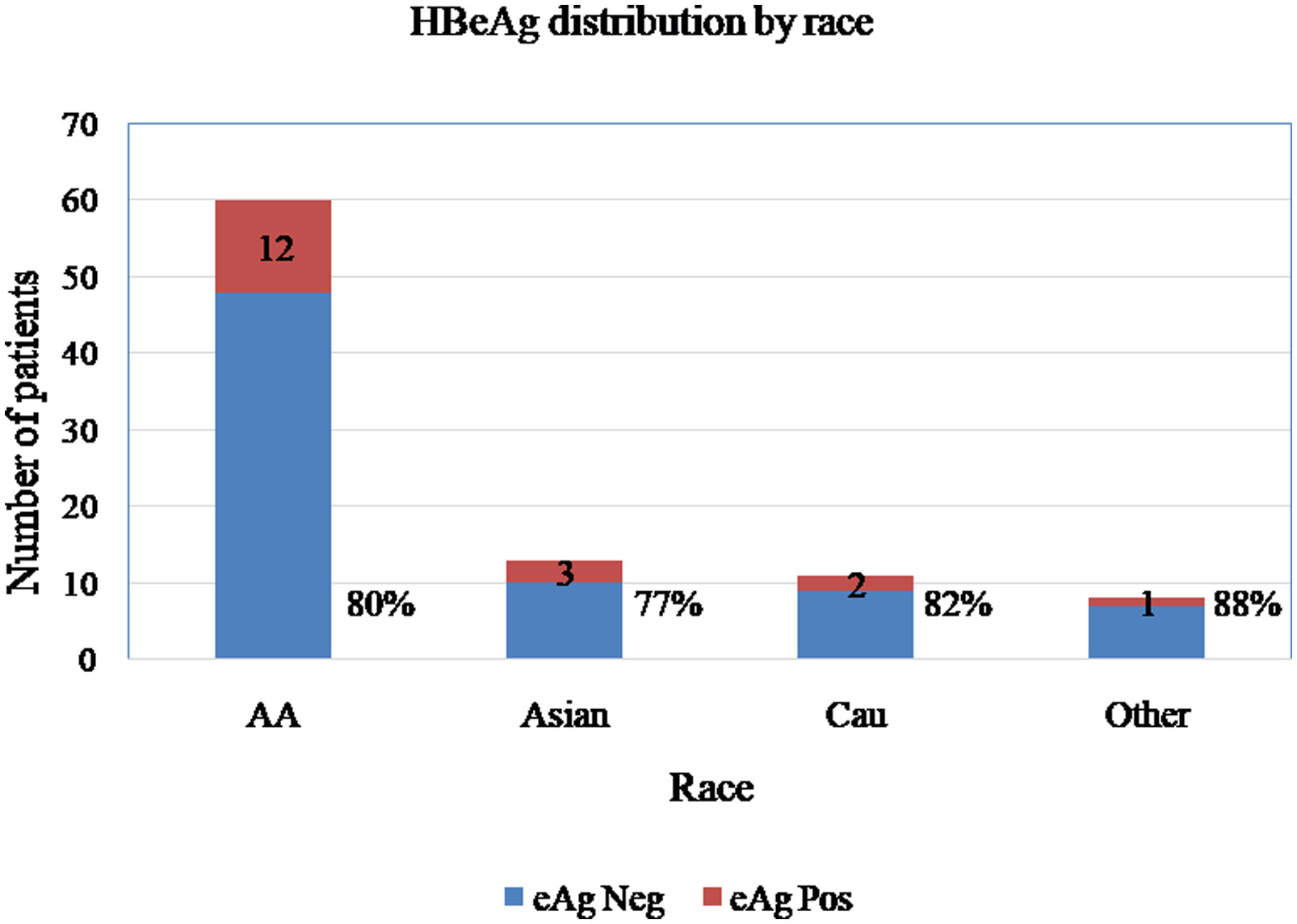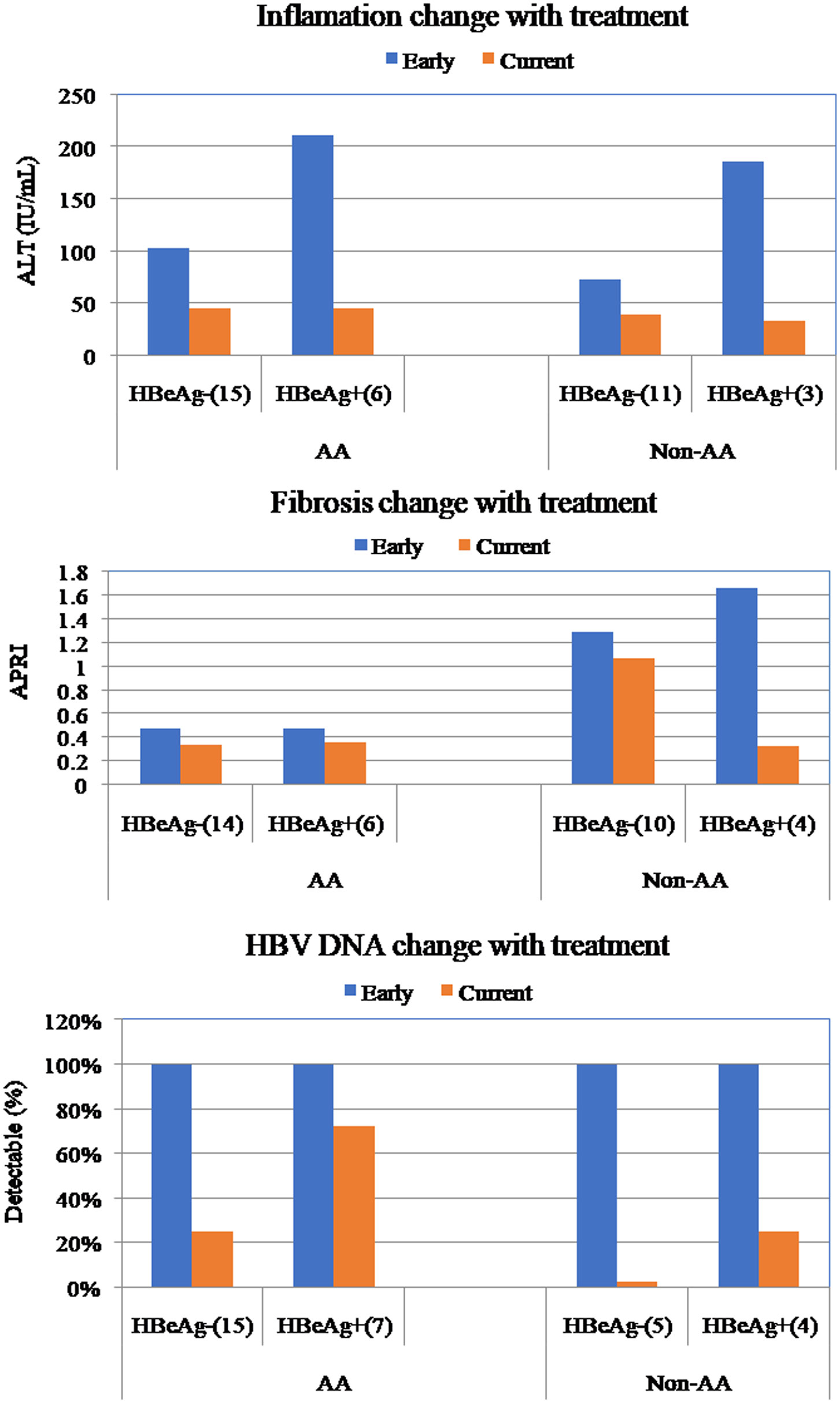1. Introduction
DNA polymerases replicate genomic DNA with extremely high fidelity [1]. A two metal ion catalytic mechanism has been widely accepted for DNA pols [2]. All DNA polymerases known to date require two and sometimes three divalent cations (usually Mg2+) for the nucleotidyl transfer reaction but only two are needed to catalyze the 3′→5′ exonuclease activity associated with replicative DNA pols. Even though DNA pols utilize the physiologically relevant Mg2+, Mg2+ can substitute for Mg2+ in the nucleotidyl transfer reaction but, when this occurs, it tends to lower the base selectivity dramatically [3,4,5,6]. Two metal ions play an important role in assembling the catalytic groups, the metal ion present in the “A” site helps to lower the pKa of the terminal 3′ OH group on the primer-terminus and coordinates both the 3′-OH of the primer strand and the α-phosphate of incoming dNTP facilitating the nucleophilic attack of the 3′-OH on the α-phosphorous of incoming dNTPs [7]. The metal ion in the “B” site coordinates the α-, β-, and γ-phosphate oxygens of the incoming dNTPs, assists in neutralizing the developing negative charge in the transition state, and assists the departure of the PPi product. The third metal ion likely helps to neutralize the negative charge built up in the transition state and may also help in protonating the leaving PPi [8]. The effect of metal ion cofactors on the fidelity of DNA replication has been studied for various pols, including E. coli DNA pol I [9], AMV DNA polymerase [10], Klenow fragment of E. coli DNA pol I [11], T4 polymerase [12], T7 DNA polymerase [13], human DNA polymerase α, human DNA polymerase β [13], Sulfolobus solfataricus DNA pol IV (Dpo4) [3] and RB69pol [14]. A number of metal ions have been shown to be mutagens and carcinogens and some may act by reducing the accuracy of DNA replication [15], although there are many other possibilities that would produce the same results such as interference by metal ions in DNA repair pathways [16].
The effect of metal ions on the fidelity of DNA polymerases is still not well understood [3,9,10,11,12,13,17]. Irima et al. have reported that Mn2+ and Ca2+ can act as cofactors for Dpo4-catalyzed polymerization but Co2+, Ni2+, Cu2+, Zn2+, Ba2+, and Sr2+ do not [6]. Pelletier et al., 1996 have studied the primer extension using pol β and showed that when crystals of pol β complexed with DNA were soaked in the presence of Ca2+, Mn2+, Co2+, Ni2+, Cu2+, Zn2+, Cd2+, and Cr3+, only Mn2+, Cd2+, and Zn2+ allowed the reaction to occur in the crystals [4]. We have recently carried out pre-steady-state kinetic analysis using RB69pol and showed that, apart from Mg2+, Mn2+, Co2+, and to a lesser extent Ni2+, these metal ions can support nucleotidyl transfer as well as the exonuclease activity of RB69pol [14]. Dpo4, Pol β and RB69pol belong to the Y-, X-, and B-families respectively, and have different preferences for divalent cations, however since there are no reports on extensive studies involving the effect of various divalent cations on the kinetics and fidelity of A-family pols we decided to determine the metal-ion cofactor preference for BST pol a high fidelity A-family DNA polymerase [18,19].
Here we report on the different divalent cations that support nucleotidyl transfer by BSTpol and we show how these divalent cations impact base selectivity by measuring the pre-steady-state kinetic parameters for primer extension with correct/incorrect incoming dNTPs. We have also determined the ground-state binding affinity of dTTP and dCTP opposite 2AP, as the templating base, in the presence of various divalent cations by observing the quenching of 2AP fluorescence as a function of [dNTP]. We have also looked at the ability of different divalent metal ions to support extension past a mismatched primer/template terminus. We have attempted to explain why BST pol can utilize only selected divalent cations as cofactors based on the properties of these metal ions and we have compared our results with other DNA pols.
2. Materials and methods
Chemicals. All chemicals were of the highest grade available and were used as purchased. dNTPs were from Roche (Burgess Hill, UK), [γ-32P]ATP was from MP Biomedicals (Irvine, CA), and T4 polynucleotide kinase was from New England Biolabs (Ipswich, MA). The metal ion salts (BaCl2, CaCl2, CdSO4, CoCl2, CuSO4, CrKSO4, MgCl2, MnCl2, NiCl2, SrCl2, FeCl2, and Zn(CH3COO)2) were from Fluka and were >99% pure.
DNA substrates and enzymes. All oligonucleotides used in this study were synthesized at the Keck facilities (Yale University). All primer strands were gel purified using PAGE (19:1% (w/v) acrylamide: Disacrylamide gels containing 8 M urea). The primer was labeled with [γ-32P]-ATP using T4 polynucleotide kinase and was annealed to unlabeled templates (in a 1:1.1 ratio) by heating to 95 °C, followed by slowly cooling to 25 °C [20]. For equilibrium fluorescence titration studies using 2AP as the templating base, the primer was annealed to the template strand containing 2AP at the templating position in a 1.1:1 ratio. The P/T sequences used in all assays are shown in Figure 1. In order to simplify data interpretation, a common primer sequence was annealed to different templates where the templating base was varied. BST pol was purified as reported earlier [21].
Steady-state kinetic assays for metal ion dependence of BST pol. Steady-state kinetic analysis was used to investigate the ability of various metal ions to support the polymerase activity of BST pol. A typical assay mixture contained 200 nM 13/18-mer (DNA13A), 40 nM BST pol enzyme and 10 mM MgCl2 in 66 mM Tris-HCl (pH 7.3). The mixture was preincubated at 23 °C for 10 min and the reaction initiated by adding 500 µM dTTP. 5 µL aliquots were withdrawn at various times (10, 20, 40, 60, and 120 s) and quenched with 0.5 M EDTA. The assay was repeated by replacing MgCl2 with BaCl2, CdSO4, CuSO4, CrKSO4, FeCl2, MnCl2, NiCl2, SrCl2, and Zn(CH3COO) [2].
Single-turnover incorporation assays for correct/incorrect incoming dNTPs catalyzed by BST pol. Rapid-chemical quench assays were performed at 23 °C with RQF3 rapid chemical quench instrument (Kintek Corporation). 1 µM BST pol was incubated with 80 nM 13/18-mer P/T (DNA13A) in assay buffer containing 66 mM Tris-HCl (pH 7.3), EDTA (0.1 mM), and mixed with dTTP (10-500 µM) containing MgCl2, MnCl2, CoCl2, or CdSO4, (10 mM) in assay buffer (final concentrations after mixing). The reactions were quenched with 0.5 M EDTA (pH 8.0) at various times ranging from 4-700 ms. For an incorrect nucleotide incorporation, the dNTP concentrations were varied from 50 µM to 3 mM and reactions were quenched at times ranging from 1-280 min. DNA Products were separated by PAGE (19:1% (w/v) acrylamide: Disacrylamide gels containing 8 M urea), visualized using a STORM imager (Molecular Imaging) and quantified using ImageQuant (GE Healthcare) and GraphPad Prizm.
Single-turnover incorporation assays for insertion and extension beyond a mismatched P/T. Single turnover experiments were carried out as described above with the exception that DNA13A was replaced with DNAACMM as shown in Figure 1. 1 µM BST pol was incubated with 80 nM DNAACMM in assay buffer containing EDTA (0.1 mM) and mixed with dATP (0.05-3 mM) containing 10 mM each Mg2+, Co2+, Mn2+ or Cd2+, in the assay buffer. The reactions were quenched with 0.5 M EDTA (pH 8.0) at various times ranging from 3 s to 80 min. Five different [dATP] were employed for each kpol and Kd,app determination.
Determination of Kdg for incoming dTTP/dCTP using equilibrium fluorescence titrations. The emission spectra of dideoxy-primer/templates (ddP/T) containing 2AP at the templating position were recorded at 23 °C with a Photon Technology International Alphascan scanning spectrofluorometer. The assay contained 200 nM P/T (DNAPdd) (Figure 1), 1 µM BST pol, and either 10 mM MgCl2, 10 mM CoCl2, 10 mM MnCl2, or 10 mM CdSO4 with varying [dTTP] and [dCTP]. Samples were excited at 313 nm and fluorescence emission spectra were collected from 335 to 450 nm. All intensities for all samples were normalized by subtracting the intensity of the blank sample and protein which contained 66 mM Tris-HCl (pH 7.3) and the metal ion. Peak emission intensities at 365 nm were plotted as a function of [dTTP] (or [dCTP]) and fit to a hyperbolic equation to obtain the ground-state equilibrium dissociation constant (Kdg) for incoming dTTP (or dCTP).
Data analysis. The amount of product formed at each [dNTP] at different times was fit by non-linear regression to Eq 1 and the observed rates of product formation at different [dNTP] were determined.
| [Product]=A[1−e−kobst] |
(1) |
Where kobs is the observed rate constant at a particular [dNTP], and A is the observed amplitude of product formation and T is time. To determine the pre-steady-state kinetic parameters kpol and Kd,app, kobs was plotted against the [dNTP] and data were fitted to Eq 2.
| kobs=kpol[dNTP]Kd,app[dNTP] |
(2) |
Where kobs is the observed rate at a given [dNTP]. In cases where saturation was not achieved with the incoming dNTP, data were fit to Eq 3.
| kobs=kon[dNTP]1+[dNTP]/Kd,app |
(3) |
Where kon is defined as the ratio of kpol to the Kd,app value for the incoming dNTP. Equilibrium fluorescence titration data were fit to the hyperbolic equation.
| f=fmax[dNTP]Kd,g+[dNTP] |
(4) |
Where f is the observed fluorescence intensity and fmax is the maximum decrease in fluorescence intensity at saturating [dTTP] and Kd,g is the ground-state equilibrium dissociation constant for the incoming dNTP.
3. Results
The effect of divalent metal ions on the replication fidelity of various pols has been studied previously but the rates of incorporation of correct and incorrect nucleotides have not been determined under single-turnover conditions in the presence of different metal ion cofactors except for Mn2+ [2,22] and Co2+ [17]. Co2+, Mn2+, and Ni2+ have been characterized as “mutagens”, since they reduce the fidelity of DNA synthesis [3,4,9,10,11,12,13]. Attempts have been made in the past to find out why these metal ions foster the mutagenic behaviors of DNA pols but most of these efforts have focused on Mn2+ [11,12,22]. Metal ions can affect the behavior of high fidelity polymerases by altering the various checkpoints along the reaction pathway. For example: 1) metal ions can affect the ground-state binding affinity of the correct and incorrect dNTPs to pol/P/T binary complexes; 2) they can promote misincorporation during primer extension; 3) intrinsic exonuclease activity can be diminished resulting in the failure to remove incorrectly incorporated dNMPs; 4) the efficiency of extension beyond the mismatch could be affected upon encountering a mismatch at the P/T terminus, resulting in mutations being embedded in the DNA; 5) the metal ion could also affect enzymes in the DNA repair pathways [16]. Here, we used BST pol, a high fidelity A family DNA replicative polymerase, to systematically study the effects of various divalent metal ions on the fidelity checkpoints during DNA replication.
Mg2+, Mn2+, Co2+, and Cd2+ can support primer extension catalyzed by BST pol. Steady-state kinetic assays were carried out with a number of divalent cations including Mg2+, Mn2+, Co2+, Ni2+, Fe2+, Ca2+, Zn2+, Cd2+, Sr2+, Ba2+, Cu2+, and Cr3+ to determine which ones were able to activate BST polymerase. Our choice of these metal ions was based on the fact that those stated above were shown to activate other pols [4,6]. We found that apart from Mg2+ and Mn2+ only Co2+ and Cd2+ supported the pol activity of BST pol. Table 1 summarizes the effect of the different metal ions on the activity of BST pol. We used 10 mM each of Mg2+, Mn2+, Co2+, and Cd2+ for pre-steady-state single-turnover experiments to investigate their effects on misincorporation and their ability to allow BST pol to extend a primer-terminus beyond a mismatch.
Table 1. Metal ion preferences for activation of BST DNA polymerase.
| Active |
Inactive |
| Mg2+, Co2+, Mn2+, Cd2+ |
Fe2+, Ca2+, Zn2+, Ni2+, Sr2+, Ba2+, Cu2+, Cr2+ |
Single-turnover kinetics for correct nucleotide incorporation by BST pol. Even though Mg2+ activates BST pol in vivo and is the physiologically relevant cation for almost all DNA pols, DNA polymerases from human [23], viral [24] and bacterial [9] sources can also utilize Mn2+, Co2+, Ni2+, and Cd2+ in vitro [4]. Dpo4 [6] is the only pol which can be activated by Ca2+ but this is an exception since Ca2+ is inactive with every other DNA pol that has been tested. We used single-turnover conditions to determine the apparent dissociation constant for dTTP (Kd,app) in the presence of Mg2+, Mn2+, Co2+, and Cd2+ where the [BST pol] was ∼12-fold greater than that of the primer-template [P/T]. The concentration of product DNA obtained at different [dTTP] were plotted against reaction time and fitted to Eq 1 to yield kobs at each [dTTP]. The kobs values were then plotted against [dTTP] which yielded a kpol of 20 ± 2 s−1 and Kd,app of 26 ± 11 µM with Mg2+. The kpol values obtained using Co2+, Mn2+ and Cd2+ were 123 ± 12, 166 ± 14, and 15 ± 1 s−1 respectively. Surprisingly, Kd,app values for the correct nucleotide incorporation were very similar with all metal ions varying between 15-28 µM. Figures 2 and 3 show the plots for dTMP incorporation opposite dA in the presence of 10 mM Mn2+, Mg2+, Co2+, and Cd2+ respectively. The results, summarized in Table 2, show that incorporation efficiencies for dTMP opposite dA (DNA13A) with Co2+, Mn2+, and Cd2+ were increased by ∼6-, ∼10-, and 1.3-fold respectively compared to Mg2+.
Single-turnover kinetics for incorrect nucleotide incorporation by BST pol. Single-turnover experiments were carried out with incorrect incoming dNTPs to study the effect of Co2+, Mn2+, and Cd2+ on base selectivity. Purine:pyrimidine, and pyrimidine:pyrimidine mismatches were tested. Table 2 summarizes the kinetic parameters obtained with these mispairs in the presence of Mg2+, Co2+, Mn2+, and Cd2+. The kpol values obtained using Mg2+, Co2+, Mn2+ and Cd2+ for dAMP incorporation opposite dC were 0.07 ± 0.01, 0.30 ± 0.02, 9 ± 1, and 0.080 ± 0.004 s−1 respectively. The Kd,app value with Mg2+ was relatively high (3000 µM) compared to other divalent cations whereby the Kd,app values varied between 67-293 µM. In general, for dAMP incorporation opposite dC, Mg2+ showed the greatest base selectivity with all the mispairs tested followed by Co2+, Cd2+, and Mn2+ (Table 2). The reduction in base selectivity with Mn2+ was a direct result of a dramatic increase in kpol with the incorrect incoming dATP. Similar trends were observed when dATP was replaced by dTTP with all divalent cations that were tested (Table 2). Figure 4 shows the plots for dTMP incorporation opposite dC in the presence of Co2+, and Cd2+ respectively.
Table 2. Summary of pre-steady-state kinetic parameters for incorporation of dNMPs by BST pol using different metal ions with 66 mM Tris-HCl (pH 7.3) at 23 °C.
| Metal ion |
dNTP |
Template |
kpol (s−1) |
Kd,app (mM) |
kpol/Kd,app (mM−1 s−1) |
| Mg2+ |
dTTP |
dA |
20 |
26 |
7.7 × 10−1 |
|
dATP |
dC |
0.07 |
3000 |
2.3 × 10−5 |
|
dTTP |
dC |
0.002 |
2600 |
7.5 × 10−7 |
| Co2+ |
dTTP |
dA |
123 |
28 |
4.4 |
|
dATP |
dC |
0.3 |
267 |
1.1 × 10−3 |
|
dTTP |
dC |
0.003 |
354 |
8.5 × 10−6 |
| Mn2+ |
dTTP |
dA |
166 |
22 |
7.5 |
|
dATP |
dC |
9 |
293 |
3.1 × 10−2 |
|
dTTP |
dC |
0.004 |
396 |
1.0 × 10−5 |
| Cd2+ |
dTTP |
dA |
15 |
15 |
1 |
|
dATP |
dC |
0.08 |
67 |
1.2 × 10−3 |
|
dTTP |
dC |
0.0005 |
174 |
2.9 × 10−6 |
| Standard deviations were within 10-20% and ∼30% for kpol and Kd,app values, respectively. |
Effect of metal ions on ground-state binding of dNTPs to pol/P/T binary complexes with Mg2+, Mn2+, Co2+, and Cd2+. We then investigated the effect of Mg2+, Co2+, Mn2+, and Cd2+ on ground-state binding affinity (Kd,g) of the incoming dNTPs. Equilibrium fluorescence titrations were carried out using a P/T containing 2AP as the templating base (DNAPdd) and the Kd,g values for dTTP binding (opposite 2AP) to a ddP/T-BSTpol binary complex were measured. The Kd,g value for dTTP binding opposite 2AP was determined by measuring the change in 2AP fluorescence observed as a function of [dTTP] in the presence of different metal ions. Scheme 1 shows the minimal kinetic scheme depicting the ground state binding affinity (Kd,g) and apparent binding affinity (Kd,app) for an incoming dNTP. In the presence of Mg2+, the Kd,g value for dTTP binding opposite 2AP was determined to be 1 µM (Table 3). Kd,g values obtained in the presence of Co2+, Mn2+, and Cd2+ were 3.3 ± 0.3, 0.10 ± 0.02, and 0.4 ± 0.1 µM respectively. Figure 5, panels A and B, show equilibrium fluorescence titration results for the BSTpol-ddP/T complex with increasing [dTTP] in the presence of Co2+ and Cd2+.
Table 3. Equilibrium fluorescence titration data for BST pol using Mg2+, Co2+, Mn2+, and Cd2+ with 2AP as the templating base.
| Metal ion P/T |
dNTP |
Kd,g (µM) |
| Mg2+ (ddP/T) |
dTTP |
1 |
| Mg2+ (ddP/T) |
dCTP |
1463 |
| Co2+ (ddP/T) |
dTTP |
3 |
| Co2+ (ddP/T) |
dCTP |
25 |
| Mn2+ (ddP/T) |
dTTP |
0.1 |
| Mn2+ (ddP/T) |
dCTP |
0.3 |
| Cd2+ (ddP/T) |
dTTP |
0.4 |
| Cd2+ (ddP/T) |
dCTP |
ND |
| The concentrations of Mg2+, Co2+, Mn2+, and Cd2+ used in the titrations were 10 mM each. Additional details are provided in the text. ND = not determined. |
We next tested whether BST pol is able to similarly discriminate against an incorrect incoming dNTP in the presence of these metal ions. The change in 2AP fluorescence was measured as a function of [dCTP] to determine the Kd,g value for dCTP binding opposite 2AP. The Kd,g values obtained for dCTP binding in the presence of Mg2+, Co2+, and Mn2+ were 1463 ± 130 µM, 25 ± 2 µM, and 0.34 ± 0.08 µM respectively. These data clearly demonstrate that compared to Mg2+, Co2+ and Mn2+ provide a ∼60-fold and ∼5000-fold tighter ground-state binding of an incorrect dNTP substrate (dCTP) respectively. Figure 6, panels A and B, show equilibrium fluorescence titrations for the BST pol-ddP/T complex with increasing [dCTP] in the presence of Mn2+ and Co2+.
Extension beyond a mismatched P/T with Mg2+, Mn2+, Co2+ and Cd2+. We next determined how efficiently BST pol could extend a duplex DNA containing a mismatch at the P/T terminus in the presence of Mg2+, Mn2+, Co2+ and Cd2+. We chose a DNA oligo containing a dA/dC mismatch (DNAACMM) as this represents a purine-pyrimidine pair containing a nascent wobble mispair having the correct size but with distorted geometry. As compared to extension past a matched base-pair at the primer terminus, where the kpol was 20 ± 2 s−1 and the Kd,app was 26 ± 11 µM, the extension past a duplex DNA containing a mismatch at the P/T terminus in the presence of Mg2+ resulted in a kpol of 0.13 ± 0.01 s−1 and a Kd,app value of 618 ± 185 µM. This sharp decrease in the kpol value (200-fold) accompanied by a substantial increase in the Kd,app value (24-fold) results in ∼4800-fold decrease in the incorporation efficiency of dNMP incorporation when BST pol encounters a dA/dC mismatch at the primer terminus in the presence of Mg2+.
With Co2+, the Kd,app was 1100 µM, higher than that obtained in the presence of Mg2+, but the kpol was 10-fold higher, showing that the incorporation of correct dNMP past the mismatched DNA was more readily accomodated compared to Mg2+. In the presence of Mn2+, the incorporation efficiency of correct dNMPs past the dA/dC mismatch was 100-fold higher than with Mg2+, demonstrating that the correct dNMP was much more readily incorporated past an dA/dC mismatch compared to Mg2+. This enhanced incorporation efficiency with Mn2+ directly resulted from a 20-fold increase in the kpol and a ∼5-fold decrease in the Kd,app values. When Mg2+ was replaced with Cd2+ in the assay, saturation with the correct incoming dNTP was not achieved so we were unable to determine the actual kpol and Kd,app values. Consequently we had to plot the rates observed versus [dNTP] and determined the kpol/Kd,app value from the slope (Eq 3). Compared to Mg2+, the incorporation efficiency of the correct dNTP showed a marginal increase (1.4-fold) in the presence of Cd2+ suggesting that, unlike Co2+ and Mn2+, Cd2+ does not promote extension past a dA/dC mismatch. The kinetic parameters for extension past a dA/dC mismatch are summarized in Table 4.
Table 4. Pre-steady-state kinetic parameters for extension beyond dA/dC mismatch for BST pol using Mg2+, Mn2+, Co2+ and Cd2+ where dAMP is being inserted opposite a templating dT.
| Metal ion |
kpol (s−1) |
Kd,app (µM) |
kpol/Kd,app (µM−1 s−1) |
| Mg2+ |
0.1 |
618 |
1.6 × 10−4 |
| Co2+ |
1 |
1100 |
9.1 × 10−4 |
| Mn2+ |
2 |
127 |
1.6 × 10−2 |
| Cd2+ |
|
|
2.3 × 10−4a |
| a: Represents the ratio of the kpol to the Kd,app value as saturation is not achieved with the incoming dNTP. Standard deviations were within 10-20% and ∼30% for kpol and Kd,app values, respectively. |
Mg2+, Co2+, Mn2+, and Cd2+ can support processive DNA synthesis with BST pol. We tested whether these divalent cations could support processive DNA synthesis by incubating BST pol with DNA13A and all four dNTPs, quenching the reaction at various times. Figure 7 panels A-D shows the full extension products obtained with Mg2+, Mn2+, Co2+, and Cd2+. The results show that all four metal ions were able to support processive DNA synthesis with BST pol. As expected with Mg2+, a fully duplexed DNA product was obtained. Intermediate products were observed from 0.05-1 s while majority of these intermediate length products were converted to full length product at the longer time points (5-30 s) (Figure 7, Panel A). Similar trends were observed when Mg2+ was replaced with Co2+ in the assay (Figure 7, Panel B). In contrast, when Mn2+ was used in the assay, up to 1 s only the full extension product was observed while at longer time points (5-30 s) an 18mer product was also found (Figure 7, Panel C). Similar to the results with Mn2+, the 18mer DNA product was also observed with Cd2+ (Figure 7, Panel D) indicating that in the presence of these two metal ions, template independent DNA synthesis can occur, in contrast to the results observed with Mg2+ and Co2+.
4. Conclusions
Several divalent cations including Co2+, Mn2+, and Ni2+ have been characterized as “mutagenic”, since they reduce the fidelity of DNA synthesis [3,9,10,11,12,13,15]. Previous attempts to address the reasons for the mutagenic behavior of these metal ions have mainly focused on Mn2+ [11,12]. For example, translesion DNA synthesis in herpes simplex virus Type I was promoted by Mn2+ [25]. Also, the rate of misincorporation opposite an abasic site by T4 DNA pol was enhanced by 11-34 fold when Mn2+ was substituted for Mg2+ [22]. In addition, studies on pol β using blunt-ended DNA showed primer-extension in the presence of Mn2+ rather than Mg2+ [4]. Moreover, the rates of incorporation of correct and incorrect nucleotides have not been determined under single-turnover conditions in the presence of different metal ions except for Mn2+ [22], and Co2+ [17].
We tested several divalent cations and found that, apart from Mg2+, only Mn2+, Co2+ and Cd2+ supported catalysis with BST pol. When Mg2+ was replaced by Co2+, the kpol for the correct incoming dTTP vs. dA increased by 6-fold. Similarly, the kpol value with Mn2+ was 8-fold higher and only slightly lower with Cd2+ compared to Mg2+. Despite the variation in kpol values, surprisingly the Kd,app values were nearly identical with all four divalent cations. It is also worth noting that the efficiency of correct insertions (dTMP vs. dA) was greatest for Mn2+ followed by Co2+, Cd2+, and Mg2+ (Table 2). This trend observed with BST pol contrasts with the results obtained with RB69pol [14], where the highest incorporation efficiency was observed in the presence of Co2+ followed by Mn2+ and Mg2+. Nevertheless, the incorporation efficiency with both pols is much higher with Co2+ as compared to Mg2+. The possible reasons for this trend are discussed below.
With incorrect incoming dNTPs the kpols were 1.5-14 times higher with Co2+ vs. Mg2+. The Kd,app values for the incorrect incoming dNTP were generally 7-11 fold lower with Co2+ vs. Mg2+. As a result, the incorporation efficiencies for incorrect incoming nucleotides were ∼10-50 fold higher with Co2+ vs. Mg2+ suggesting that base discrimination is greatly reduced with Co2+ vs. Mg2+. This trend observed with BST pol stands in contrast to similar studies carried out using RB69pol [14] whereby the Kd,app values did not show any clear trend (e.g. the Kd,app value for dATP binding opposite dC was nearly identical with both Mg2+ and Co2+, slightly lower with Co2+ with dTTP vs. dC and much higher with Co2+ when dGMP incorporation was measured opposite dA). A similar trend was observed with Cd2+. This decrease is much less pronounced compared to the situation where Mn2+ was used in place of Mg2+ whereby the kpols/Kd,app values were 13-1300 fold higher as compared to Mg2+ with the largest differences observed when dAMP was incorporated vs. dC (kpol = 9 s−1 and Kd,app = 293 µM with Mn2+ compared to kpol = 0.07 s−1 and Kd,app = 3000 µM with Mg2+). Interestingly, most of the enhancement in incorporation efficiencies resulted from a sharp increase in kpol values in the presence of Mn2+. Surprisingly, the kpol values for misincorporation were similar for both Cd2+ and Mg2+. Moreover, the Kd,app values were 4-50 fold lower with Cd2+ vs. Mg2+ suggesting that Cd2+ reduces base selectivity.
Wang et al. [26] have provided structural evidence for the rare tautomer hypothesis of spontaneous mutagenesis using the D598A/F710Y double mutant of BST pol. They showed that in the presence of Mg2+ when dCMP incorporation was observed opposite dT, the polymerase adopts an “ajar” or partially closed conformation which prevents the mismatch incorporation. Additionally, the triphosphate tail of dCTP is not properly aligned for catalysis. In contrast, in the presence of Mn2+, the C/A mismatch adopts a tautomeric cognate base-pair shape, that is virtually indistinguishable from a canonical, Watson-crick base pair in double stranded DNA in the insertion site [26]. Moreover, the triphosphate tail is properly aligned for catalysis, and the polymerase is also observed in the closed conformation. These results support our kinetic data when we had dATP opposite dC with Mg2+ and Mn2+ where the kpol value was ∼130-fold higher with Mn2+ vs. Mg2+. This could explain why the rates of misincorporation are higher in the presence of Mn2+ compared to Mg2+. Similarly, the triphosphate tail is likely to be in the proper orientation for catalysis in the presence of Co2+ and mimics the T/A Watson-crick base pair explaining the higher kpol values observed with Co2+ vs. Mg2+. Even though crystal structures with bound Co2+ and Cd2+ are currently not available, based on the kinetic parameters we can speculate that, similar to Mn2+, the C/A mismatch adopts a tautomeric cognate base-pair shape and the triphosphate tail is likely to be properly aligned for catalysis with Co2+ and Cd2+. This could explain the higher kpol values and lower Kd,app values observed with these divalent cations. Support for this notion will require further crystal structure evidence which could directly show that a C/A mismatch adopts a cognate shape mimic for BST pol in the presence of Co2+ and Cd2+.
With respect to the ground-state binding affinities for dTTP vs. dAP, as measured by 2AP fluorescence quenching, the lowest dissociation constant (Kdg) was observed with Mn2+/BSTpol complex followed by Cd2+, Mg2+ and then Co2+. Surprisingly, with BST pol, in the presence of Co2+, the Kd,g value for dTTP binding opposite 2AP was 3-fold higher as compared to Mg2+ but with RB69pol, the Kd,g value was 5-fold lower [17]. For an incorrect dNTP (dCTP vs. 2AP) there was a difference of 1400-fold in Kd,g values with Mg2+ as compared to dTTP vs. 2AP which clearly shows that, in the presence of Mg2+, BST pol discriminates well between the correct and incorrect incoming dNTP. This trend is very similar to that observed with RB69pol even though the discrimination is more selective with BST pol (1400-fold) compared to RB69pol (40-fold) suggesting that these pols behave very differently in terms of their ability to discriminate among the incoming dNTPs. In contrast, discrimination in ground state binding affinity sharply dropped to only 8-fold and 3-fold with Co2+ and Mn2+ respectively. In the presence of Co2+, the Kd,g for dCTP binding opposite 2AP was much lower (25 µM) with BST pol as compared to RB69pol where the Kd,g value could not be determined as saturation with dCTP was not attained. With Mn2+, this value was ∼5000-fold tighter as compared to Mg2+ and ∼80-fold tighter compared to Co2+. Clearly, the difference in ground-state binding affinities observed with BST pol with Mg2+, Mn2+, Co2+, and Cd2+ are more varied compared to similar data obtained with RB69pol [14].
Primer extension past dA/dC mismatch. The number of errors in nascent DNA can be increased if the DNA pol extends beyond a mismatch at a P/T terminus [27]. When we investigated the influence of divalent cations on the ability of BST pol to extend the primer past a dA/dC mismatch, we found that the efficiency of incorporation was highest with Mn2+ followed by Co2+, Cd2+, and Mg2+ (Table 4). This trend mainly resulted from an increase in kpol values with Mn2+, and Co2+ compared to Mg2+ while the Kd,app values did not show a great deal of variation. On the other hand, when a dA/dC mismatch was extended by BST pol with Cd2+, the incorporation efficiency was marginally higher as compared to Mg2+. Since saturation was not achieved with incoming dNTP we only determined the kpol/Kd value with Cd2+. The structural evidence for rare tautomer hypothesis provided by Wang et al. [26] also supports the mismatch bypass experimental data. The 20-fold higher kpol value obtained in the presence of Mn2+ could be explained on the basis of the formation of dA/dC tautomeric cognate base-pair at the P/T junction, which resembles a canonical dA/dT base pair and hence the polymer is likely not able to sense the presence of a mismatch at the primer terminus and is able to readily extend past the mismatch. On the other hand, in the presence of Mg2+, the dA/dC mismatch forms a wobble base pair at the primer terminus and the polymerase is not able to readily incorporate the incoming dNTP past this mismatch resulting in reduced kpol values. This explanation could also be extended to the kinetic data obtained with Co2+ resulting in a 10-fold increase in the kpol value as compared to the situation when Mg2+ is the divalent cation.
Effect of active metal ions on full extension with BST pol. We tested the ability of four divalent cations to support processive DNA synthesis and found that BST pol is able to carry out full length primer extension with Mg2+, Mn2+, Co2+, and Cd2+. In particular, the results obtained with Mn2+ and Cd2+ are quite interesting as we observed 18 mer products with both these metal ions even though a 13/17 mer DNA P/T was utilized suggesting that BST pol is able to carry out template independent DNA synthesis in the presence of these two metal ions. Similar results have been reported by Pelletier et al. with pol β [4] where they observed primer extension in crystal soaking experiments in the presence of Mn2+ and Cd2+.
Comparison of the properties of various divalent cations. Several properties of divalent cations such as their ability to lower the pKa of the 3′ OH group, their ionic radii, and their coordination geometry preferences are crucial in order to determine if a given divalent cation could serve as a cofactor for DNA pols. One of the most important factors appears to be the ability of the divalent cation to enhance the nucleophilicity of the 3′ OH group of the primer by lowering its pKa so that it can attack the α-phosphate atom of the incoming dNTP. In this respect, the effect on reducing the pKa of bound water is lowest for Fe2+ (8.4), and is about the same for Co2+, Cd2+, and Zn2+ (9.4, 9.8, and 9.6 respectively), slightly higher for Mn2+, and Ni2+ (10.1 and 10.6), and considerably higher for Mg2+ and Ca2+ (11.4 and 12.8) (Table 5). Based on these values, Co2+, Cd2+, and Zn2+ would be expected to be more effective as cofactors but that is clearly not the case as Zn2+ is not active at all with BST pol. Moreover, Ni2+ is also not able to support the polymerase activity of BST pol despite having a comparable pKa value. On the other hand, Ca2+ does not lower the pKa of the 3′ OH group of the primer and thus is not able to support catalysis except for Dpo4 which is the only pol able to utilize Ca2+ [6]. Surprisingly, Fe2+ provides the maximum decrease in the pKa of the 3′ OH group but is ineffective as a cofactor for BST pol or RB69pol [17]. Hence, the ability of divalent cations to lower the pKa of the 3′ OH group is not the sole factor for promoting catalysis. For example, the divalent cation occupying the “A site” helps to determine the proximal distance between the α-phosphorous atom of the incoming dNTP and the 3′-hydroxyl group during the transition state. The ionic radii of Mg2+ is 0.86 Å, very similar to that of Mn2+, Co2+, Ni2+ and Zn2+, while the ionic radii of Cd2+ and Fe2+ is slightly higher (0.95 and 0.92 Å). Based on similar values, the ionic radii of Mg2+, Mn2+, Co2+, Ni2+, and Zn2+ should allow these metal ions to bring the 3′-hydroxyl group and α-phosphate atom of the incoming dNTP close enough for reaction but despite this, Ni2+ and Zn2+ fail to support catalysis with BST pol and Ni2+ is only a weak cofactor for RB69pol [17]. In contrast, Cd2+ does support BST pol activity and the kpol value with Cd2+ is only slightly lower than the value obtained with Mg2+ while Fe2+ whose ionic radii is very similar to Cd2+ fails to catalyze nucleotidyl transfer reaction. The ionic radii of Ca2+ is 1.1 Å, thus accounting for its inability to bring the 3′-hydroxyl group and α-phosphate atom of the incoming dNTP within range for the reaction to occur so Ca2+ is not able to support catalysis with almost all pols except for Dpo4 [17].
Table 5. Ionic radii, coordination geometry, and pKa of water molecules coordinated to (Mg2+, Co2+, Mn2+, Cd2+, Fe2+, Ni2+, Zn2+, and Ca2+).
| Metal ion |
|
Mg2+ |
Co2+ |
Mn2+ |
Cd2+ |
Fe2+ |
Ni2+ |
Zn2+ |
Ca2+ |
| Ionic radius (Å) |
0.86 |
0.89 |
0.81 |
0.95 |
0.92 |
0.83 |
0.88 |
1.1 |
| Coordination |
Oct |
Oct |
Oct |
Oct |
Oct |
Oct |
Oct |
Oct |
| geometrya |
Td |
Td |
Td |
Td |
Td |
Td |
Tda |
Td |
|
Sq |
Sq |
|
HBP |
|
TBP |
TBP |
HBP |
|
TBP |
TBP |
|
|
|
|
|
|
| pKa of the water molecule |
11.4 |
9.4 |
10.1 |
9.8 |
8.4 |
10.6 |
9.6 |
12.8 |
Td represents Tetrahedral; Sq represents Square planar; TBP represents Trigonal bipyramidal; Oct represents Octahedral; PBP represents pentagonal bipyramid; and HBP represents hexagonal bipyramidal.
a: Even though Zn2+ can form octahedral complexes, the majority of Zn2+ complexes are tetrahedral. |
Apart from these factors, the preference of different divalent cations for a given coordination geometry plays a critical role in the nucleotidyl transfer reaction. Studies by Xia et al. [7] showed that the metal ions (Mg2+ and Mn2+) present in the B site is in perfect octahedral geometry while the metal ion in the A site is present in a distorted octahedral geometry. In addition to Mg2+ and Mn2+, Co2+, Cd2+, Fe2+, and Ni2+ are also able to form octahedral complexes and can potentially support the reaction with BST pol but Fe2+, and Ni2+ are not cofactors for BST pol. Ca2+ can also form octahedral complexes but due to its much larger ionic radii it prefers pentagonal bipyramidal and hexagonal bipyramidal geometries. The inability of Zn2+ to act as a cofactor for BST pol despite its ability to effectively lower the pKa of hydroxyl group and its similar ionic radii compared to Mg2+ could be explained on the basis of its preference for tetrahedral as opposed to octahedral geometry. The ability of only selected divalent cations (including Mg2+, Co2+, Mn2+, and Cd2+) to act as cofactors for BST pol is consistent with: 1) their ability to effectively lower the pKa of the water molecule (and presumably the 3′-hydroxyl group of the primer); 2) similar ionic radii of these metal ions; 3) the ability of these metal ions to form octahedral complexes [28]. The highly mutagenic behavior of Mn2+ as compared to Mg2+ can be explained on the basis of the more polarizable nature of Mn2+ [28]. Also, in the context of a hexahydrated metal complex (Mn[H2O]62+, Mg[H2O]62+) there is a greater energy penalty with Mg2+ compared to Mn2+, when the inner sphere coordination number is changed from 6→5→4, indicating more rigid coordination requirements for Mg2+ complexes compared to Mn2+. This in turn allows dNTPs (correct and incorrect) to be accessible to the nucleotide binding pocket with Mn2+ [29]. In addition, the ability of transition metal ions to bind more tightly to the triphosphate moiety of dNTPs and carboxylate groups as compared to Mg2+, could explain the lower base selectivity in the presence of Mn2+ [4].
Comparison of metal ion preferences for different DNA polymerases. Mg2+ is the universal metal ion cofactor for all DNA polymerases. Even though Mg2+ is preferred by pols, Mn2+ and Co2+ can also be used in place of Mg2+ but this usually results in a decrease in replication fidelity [9,10,11,15]. Crystal soaking experimental studies on pol β have shown that Cd2+, and Zn2+ were able to act as cofactors of pol β [4] while one study shows that BST pol was only able to utilize Cd2+. On the other hand, both these divalent cations were inactive with RB69pol [14]. Ni2+ has been shown to support catalysis for all DNA polymerases albeit with greatly reduced activity except for human pol α [30], human pol β [4], and Dpo4 [6]. Our results show that Ni2+ is also not able to activate BST pol. Interestingly, Fe2+ exhibits properties conducive to supporting catalysis with pols but fails to catalyze nucleotidyl transfer with BST pol, RB69pol [17,31] and HSV-1 pol [32,33] but the reason for this is not clear.
In summary, Mg2+ is the best divalent cation cofactor for pols in terms of the rate of nucleotidyl transfer reaction, base selectivity, exonuclease activity, and the efficiency of extension past mismatched DNA. Other divalent cations can substitute for Mg2+ but they affect the various fidelity checkpoints in the minimal kinetic scheme (Scheme 1) and their effect varies with the nature of the metal ion. Our results, together with previous studies on other pols, show that DNA polymerases from different families show preferences for different metal ions but we cannot predict, as yet, which ones will work based solely on their properties that we have described above.
Acknowledgements
We thank Lorena Beese for the BST pol over-expressing plasmid.
This work was supported by a grant (GM063276-9) from the National Institute of Health (to W. H. Konigsberg) and a gift from the Frank and Suzanne Konigsberg fund.
Conflict of interest
The authors declare no competing financial interests.









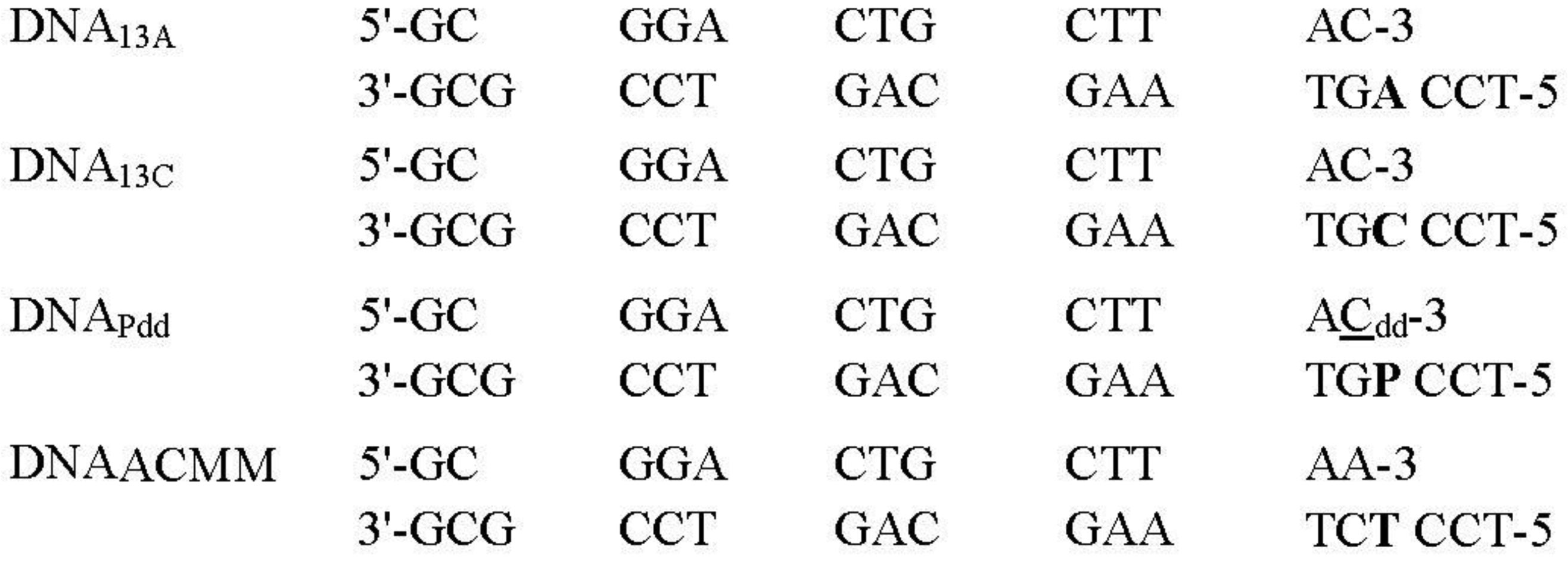
 DownLoad:
DownLoad: 